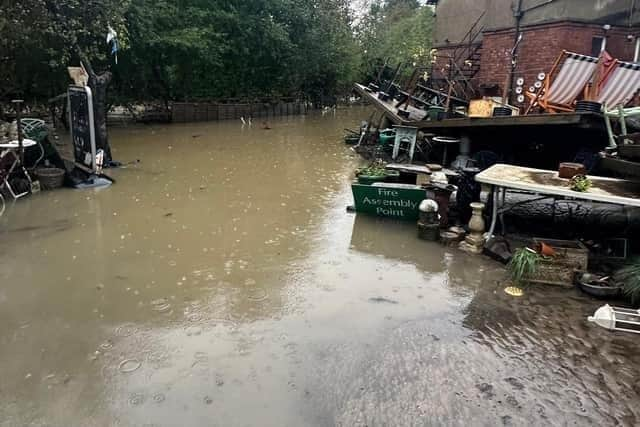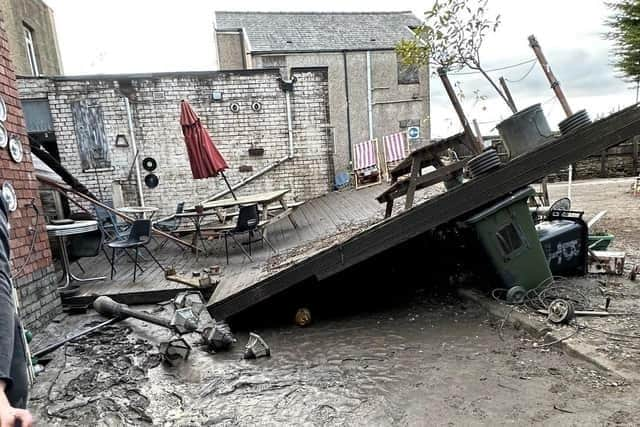Environment chiefs say costly dredging may not be the most efficient way to protect Derbyshire’s vulnerable flood-hit areas
and live on Freeview channel 276
The possibility of considering dredging Derbyshire’s waterways has surfaced following the Government’s announcement that financial support from its Flood Recovery Framework scheme for the worst-hit areas of the country is to be made available for various support projects.
Some residents in the worst affected areas have suggested that, if nearby rivers had been dredged, their homes and businesses may not have been flooded - including the owner of a Chesterfield antiques centre which was submerged in five feet of water during Storm Babet and who has called for the River Rother to be dredged.
Advertisement
Hide AdAdvertisement
Hide AdThe Environment Agency stated that dredging and desilting rivers can be effective when used with other flood risk management measures, but they are not always the most efficient ways of reducing flood risk and can actually increase flood risks for downstream communities.


An Environment Agency spokesperson said: ““We know the devastating impact that flooding can have, which is why protecting people and communities is our top priority.
“We can reduce flood risk in many ways, including building flood defences, working with our partners to increase resilience to flooding, and maintaining watercourses – which where appropriate, may include dredging.
“Dredging means different things to different people. Within the Environment Agency we mean removing accumulated material in the river to maintain the conveyance of the channel.
Advertisement
Hide AdAdvertisement
Hide Ad“This includes material like gravel or soil – often referred to as silt – that has been washed into rivers from somewhere else, as well as rocks and plant life.


“Other maintenance activities such as in-channel weed clearance, blockage removal and vegetation management are also important to maintain the conveyance of channels.
“The Environment Agency prioritises those activities which achieve the greatest benefit in terms of better protecting people and property from flooding.
“Dredging and clearing channels are important parts of the Environment Agency’s maintenance regime, when they improve the channel’s ability to carry increased river flows and manage flood risk.”
Advertisement
Hide AdAdvertisement
Hide AdDerbyshire, and particularly Chesterfield, Derby and the Peak District, was swamped with torrential rainfall with rivers bursting their banks while homes, businesses and roads were flooded after the storm struck between Friday, October 20, and Saturday, October 21.
Sofia Brown, who runs Olympia House Antiques Centre, in Chesterfield, said her family has been calling for the River Rother to be cleaned out since the 90s, following floods in 2007, 2019, and now in 2023.
She estimates that around seven-feet of silt has accumulated in the water near her family-run business and she believes having the nearby River Rother dredged would lower the water level significantly and allow boats to pass under the arches of the nearby bridge on Brimington Road.
Sofia told the Derbyshire Times: “If they had dredged it in the 90s we wouldn’t have had the floods of 2007, 2019 and now 2023. The silt is so high there’s a shopping trolley which has been in the river for years which has completely disappeared now – it’s buried.”
Advertisement
Hide AdAdvertisement
Hide AdSofia’s flood insurance covers her for up to 40 per cent of the cost, leaving her with a bill of around £15,000 in terms of damages and lost stock. Her family business hopes to reopen within two months.
Dredging and desilting helps to remove an accumulation of silt material and temporarily increase the water flow after fine gravels or soils have been washed into rivers from surrounding land.
The two processes help to drain land, maintain flows to mills, abstract sand or gravel for construction and improve navigation, and they can help prevent flooding, according to the Environment Agency, but they can increase flooding problems further downstream.
An Environment Agency spokesperson stated that dredging and desilting are not as effective at reducing flood risk as other options and they are often expensive processes that can be harmful to the environment so the level of dredging and desilting has actually decreased in the UK in recent decades.
Advertisement
Hide AdAdvertisement
Hide AdAlso, natural processes in many rivers means silt will return and accumulate in the same places very quickly, sometimes only weeks after dredging and desilting has been carried out, so any increase in channel capacity will be short-lived, according to the Environment Agency.
The Environment Agency spent around £5m on these type of activities in 2019/20, in addition to approximately £40m it spent on other works in channels such as weed clearance and blockage removal to keep waterways flowing.
It states that it considers every possible location carefully and dredges where it knows it will make a difference to reduce flood risks after assessing each situation on its merits to understand the effectiveness, sustainability, environmental impact and value for money that any dredging and desilting may provide.
Alternatively, the Environment Agency uses flood walls, embankments, and demountable and temporary barriers which help to contain water within river channels and it claims its new defences have meant that 314,000 homes are now better protected since 2015.
Advertisement
Hide AdAdvertisement
Hide AdIn addition, the Environment Agency’s delivery of a record £5.2bn investment in around 2,000 new schemes across the country expects to result in a further 336,000 better protected properties.
It works with other agencies to carry out activities in the upper catchments of rivers, restoring peatlands, planting trees, and building dams which contribute to slowing the flow of water into communities further downstream.
The Environment Agency also works with local authorities and other partners to promote sustainable drainage systems.
Other maintenance activities such as in-channel weed clearance, blockage removal and vegetation management are also important aspects of the Environment Agency’s work to maintain the conveyance of channels.
Flooded households in affected areas will soon be able to apply for up to £500 to quickly help with immediate costs as part of the Government’s Flood Recovery Framework scheme .